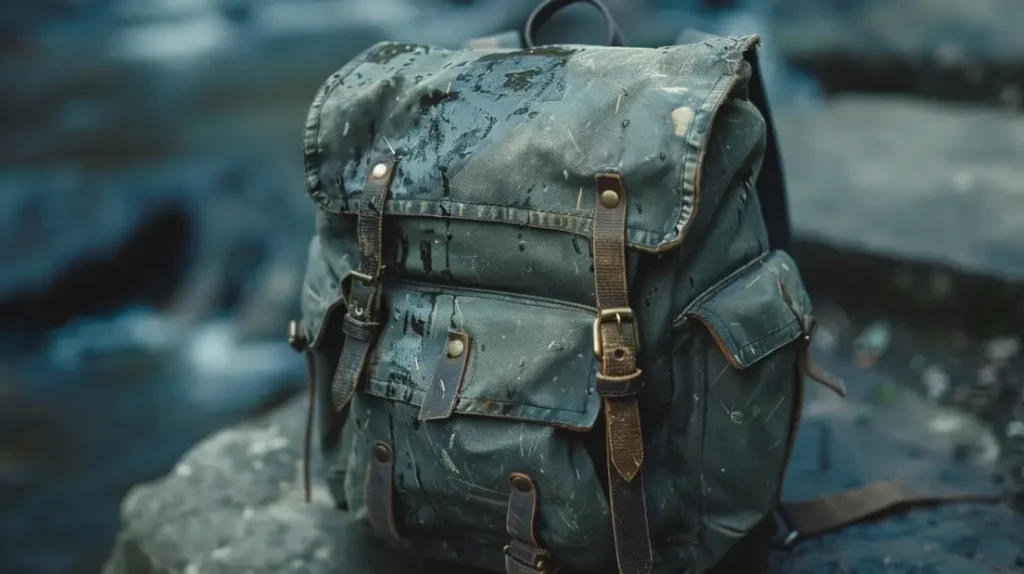Ever spilled coffee or dropped your lunch in your backpack? It’s frustrating when a stain mars your trusty bag. But don’t worry, you don’t need fancy cleaners or a trip to the dry cleaners to fix it.
Key Takeaways
- Understand Stain Types: Different stains such as food, beverage, ink, and dirt each require specific treatments. Knowing the stain type helps in choosing the right solution.
- Essential Tools and Ingredients: Having a soft brush, clean cloths, mild detergent, white vinegar, baking soda, rubbing alcohol, hydrogen peroxide, and spray bottles are crucial for DIY stain removal.
- Workspace Preparation: Set up a well-ventilated, protected space and test cleaning solutions on inconspicuous areas to prevent fabric damage.
- Effective Stain Removal Steps: Detailed steps for treating oil-based stains, ink and dye marks, and food and beverage spills ensure thorough cleaning without damaging your backpack.
- Preventative Measures: Regular maintenance, spot cleaning, and proper storage can keep your backpack looking fresh and extend its lifespan.
Understanding Stain Types
Different stains require specific treatments, which is why knowing what kind of stain you’re dealing with is crucial. Let’s dive into the most common backpack stains and their impacts on fabric.
Identifying Common Stains on Backpacks
You’ll often find several types of stains on backpacks:
- Food Stains: These include sauces, oil, and chocolate. They can be greasy or sticky, making them challenging to remove.
- Beverage Stains: Coffee, tea, and juice often leave noticeable marks. They might spread quickly and set in fast.
- Ink Stains: Pen and marker stains can be stubborn. They usually require special attention due to their pigment.
- Dirt and Mud Stains: These are regular, especially if you use your backpack outdoors. They might be mixed with grass or other organic materials.
Impact of Different Stains on Fabric
Different stains impact fabric in various ways. Here’s how:
- Food Stains: Greasy stains can weaken fabric fibers over time if not treated promptly. Sticky residues may attract dirt.
- Beverage Stains: Liquid stains can penetrate deep into the fabric, making them harder to treat the longer you wait.
- Ink Stains: Ink can become permanent if it seeps into synthetic fibers. Removing ink might require solvents that can affect fabric color.
- Dirt and Mud Stains: While generally easier to remove when dry, dirt stains can cause abrasion, wearing down the fabric.
Understanding these common stains and their impact can help you decide the best DIY solution to use for your backpack.
Essentials for DIY Stain Removal
When tackling a stain on your backpack, certain essentials make the process easier and more effective.
Tools and Ingredients Needed
For effective DIY stain removal, you’ll need various tools and ingredients:
- Soft Brush or Toothbrush: Ideal for scrubbing out stains gently.
- Clean Cloths and Towels: Useful for blotting and drying.
- Mild Detergent: Gentle enough for fabric, strong enough to tackle stains.
- White Vinegar: Helps break down stubborn stains.
- Baking Soda: Excellent for odor removal and scrubbing.
- Rubbing Alcohol: Effective on ink and dye stains.
- Hydrogen Peroxide: Acts as a bleaching agent for tough stains.
- Spray Bottles: Useful for applying cleaning solutions.
Preparing Your Workspace
Set up your workspace to ensure efficiency and cleanliness:
- Choose a Well-Ventilated Area: Ensure proper air circulation when using strong-smelling agents.
- Lay Down Protective Covering: Use old towels or plastic sheets to protect surfaces from cleaning agents and water.
- Gather All Necessary Tools: Have your brush, cloths, and cleaning solutions within reach to streamline the process.
- Test Cleaning Solutions: Before applying any cleaner, test it on a small, inconspicuous area of the backpack to prevent fabric damage.
By having these tools and preparing your workspace, you’re set up for successful DIY stain removal on your backpack.
Step-by-Step Guide to Removing Stains
Follow these steps to effectively remove different types of stains from your backpack using DIY solutions. Ensure you have the necessary tools and ingredients ready from the previous section.
Treating Oil-Based Stains
1. Blot the Area: Dab the stain with a paper towel to absorb excess oil. Avoid rubbing to prevent spreading.
2. Apply Baking Soda: Sprinkle a generous amount of baking soda on the stain. Let it sit for 30 minutes to an hour.
3. Brush Off Residue: Use a soft-bristle brush to remove the baking soda.
4. Apply Dish Soap: Mix a few drops of mild dish soap with warm water. Dab the soapy water onto the stain with a clean cloth.
5. Rinse and Dry: Rinse the area with warm water and pat dry with a towel. Let the backpack air dry completely.
Treating Ink and Dye Marks
1. Test Alcohol Solution: Apply a small amount of rubbing alcohol on an inconspicuous spot to ensure no color damage.
2. Dab with Rubbing Alcohol: If safe, pour a small amount of rubbing alcohol on a cotton ball. Dab the ink stain gently.
3. Blot with Paper Towel: Blot the area with a fresh paper towel to lift the ink.
4. Repeat if Necessary: Repeat the process until the ink stain fades.
5. Rinse and Dry: Rinse the treated area with cold water. Pat dry and air dry completely.
Addressing Food and Beverage Spills
1. Blot the Spill: Blot the spill with a paper towel. Start at the edges and move inward to prevent spreading.
2. Use White Vinegar Solution: Mix equal parts white vinegar and water. Dab the solution onto the stain with a clean cloth.
3. Scrub with Mild Detergent: Apply a small amount of mild detergent to a soft-bristle brush. Gently scrub the stained area.
4. Rinse Thoroughly: Rinse the area with cold water to remove vinegar and detergent.
5. Air Dry: Pat the area dry with a towel and let the backpack air dry completely.
Preventative Measures for Backpack Care
Taking proactive steps can keep your backpack looking fresh and extend its life.
Daily Maintenance Tips
Regularly wipe down your backpack to remove surface dirt. Use a damp cloth for non-fabric areas. Empty your backpack nightly to shake out crumbs and dirt. Spot clean minor spills immediately with a mild detergent solution. Carry a small travel pack of wet wipes for quick clean-up on the go.
Long-Term Storage Solutions
Clean your backpack thoroughly before storing it. Ensure all compartments are dry to prevent mold. Store your backpack in a cool, dry place away from direct sunlight to avoid fabric fading. Use a breathable cotton storage bag or a pillowcase to prevent dust accumulation. Avoid hanging the backpack by its straps; lay it flat or stand it up on a shelf to maintain its shape.
Conclusion
Taking care of your backpack doesn’t have to be a daunting task. By understanding the different types of stains and using the right DIY methods, you can keep your backpack looking fresh and clean. Regular maintenance and proper storage will go a long way in extending its lifespan. So next time you encounter a pesky stain, you’ll be well-equipped to handle it and keep your backpack in top shape. Happy cleaning!
Frequently Asked Questions
How can I remove food stains from my backpack?
To remove food stains, first, blot the stain with a clean cloth to soak up excess residue. Then, apply a mixture of mild detergent and water to the stain and gently scrub with a soft brush. Rinse thoroughly and air dry.
What’s the best way to deal with ink stains on my backpack?
For ink stains, use rubbing alcohol on a cotton ball and dab the stained area carefully. Blot until the ink lifts, then rinse with water and let the backpack air dry.
How often should I clean my backpack?
Regularly spot clean your backpack as needed, and aim for a thorough cleaning every few months or when visible dirt accumulates.
Can I use a washing machine to clean my backpack?
It depends on the backpack material. Check the manufacturer’s care instructions. If machine-washing is permitted, use a gentle cycle with mild detergent and place the backpack in a laundry bag.
What daily maintenance tips can keep my backpack in good condition?
Wipe down your backpack daily with a damp cloth to remove dust and dirt. Spot clean any spills immediately and carry wet wipes for quick clean-ups on-the-go.
How should I store my backpack for long-term periods?
Clean your backpack thoroughly before storing. Ensure all compartments are dry to prevent mold. Store the backpack in a cool, dry place away from direct sunlight, using a breathable storage bag, and avoid hanging it by its straps.
How do I prevent dirt stains on my backpack?
Prevention includes regular wiping down of the backpack, avoiding placing it on the ground, and storing it in a clean, dust-free environment when not in use.
Is there a way to prevent mold from forming in stored backpacks?
Yes, make sure your backpack is completely dry before storing. Store in a cool, dry place and avoid any damp areas to prevent mold growth.
Can I use bleach to clean tough stains on my backpack?
Generally, bleach is not recommended as it can damage the fabric. Opt for mild detergents or specific fabric cleaners to avoid harsh chemical effects on your backpack.
What should I do if my backpack retains an odor after cleaning?
If odors persist, sprinkle baking soda inside the backpack and let it sit for a day before vacuuming it out. Alternatively, place dryer sheets or sachets of activated charcoal inside to absorb the odor.



